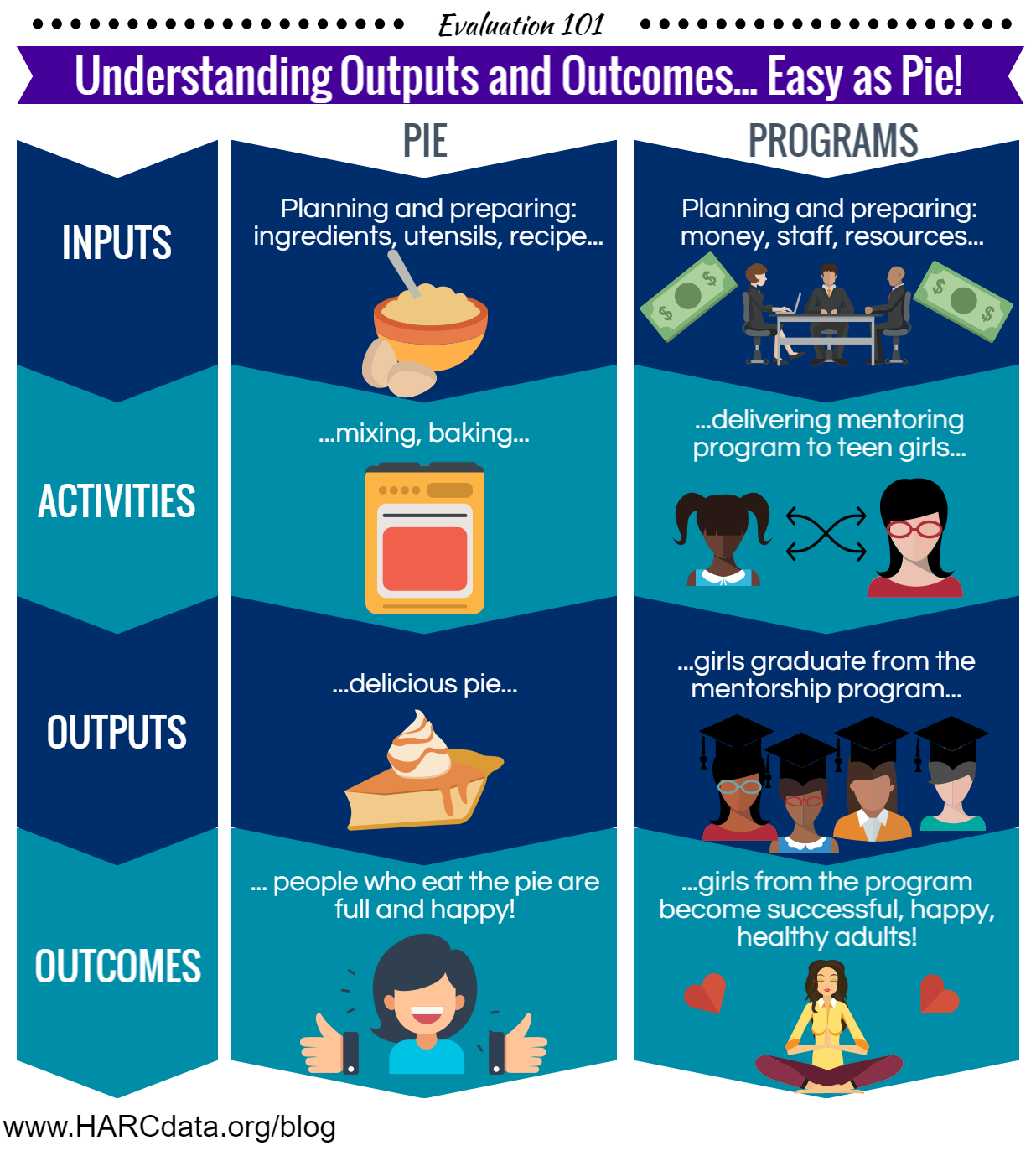
Understanding outputs and outcomes: Easy as pie!
Outputs and Outcomes
All fields have jargon that only they understand. I personally feel like jargon/specialized terminology just makes it more difficult to understand each other, and to draw parallels from the work you do to the work others do (which are often quite strong, despite different word use).
One source of terminology confusion in evaluation is the difference between outputs and outcomes. Both of these are things that you measure to demonstrate your impact (which, as mentioned in a previous post, is sooooo important!). So today I wanted to demonstrate the difference between the two and make it easy as pie for you to grasp and remember.
Definitions are as follows:
- Outputs: Hard numbers, relatively easy to measure, often the only evaluation data a nonprofit can easily gather without an evaluation plan/activities
- Outcomes: Big picture statements, what has changed as a result of your actions?
Let’s say you have a mentoring program for young girls. I’m thinking in particular about one of our community partners, the Ophelia Project. The Ophelia Project provides mentoring during the school day, at the school, at the invitation of the school districts. Mentors are adult women who go to the schools twice a month to spend time with their mentees. The curriculum is diverse, and encourages things like completion of high school, goal-setting, honing artistic skills, understanding healthy relationships, building self-confidence, gaining financial literacy, substance abuse prevention, and much more.
Outputs
For a program like the Ophelia Project, expected outputs would be something like this:
- At least 50 girls participate in the program in the 2017-2018 school year
- At least 5 different high schools are actively engaged in the Ophelia Project
- At least 25 different mentors are involved in the program
Those things are all fairly easy to track, assuming you’re running the program with some degree of record-keeping. Teens are screened into the program, so you have files on each one. High schools have signed agreements on file so you can track how many are participating, Mentors must go through background checks and extensive training, so your documentation can show you how many mentors are active and who they are. Basically, you can get most of this information from combing through your records.
Outcomes
Now what would the outcomes be? It would likely include things like…
- At least 80% of the girls in the program increased their levels of self-esteem
- At least 95% of the girls in the program have a GPA of 3.0 or above
- School administrators perceive the program as worthwhile and valuable for improving student lives
- Mentors find their experience to be rewarding
Basically, think of outputs as “how many people did we touch with our program?” and outcomes as “how did it change their lives?”. (My memory trick is that the “p” in “outputs” stands for “program”, and the “c” in “outcomes” stands for “change”.)
Goal Setting with Outputs and Outcomes
One of the first questions that I asked when I first started doing evaluation was, “where do those numbers come from?” How do you set that 90%, 85%, 90% benchmarks? The short answer was “kind of off the top of my head”.
The long answer is that these numbers need to be challenging, but realistic and specific (like all good goals). Realistic means that you should never set your goal at 100% (or 0%, if your goal is to reduce negative behavior).
(Although, you should also never say never, so maybe there are a few situations out there when 100% accomplishment of good things or 0% of bad things is a realistic goal… but not often).
Other than that, it depends on your program. If you’ve done this before, base your goals on prior experience. Even if your prior mentoring sessions didn’t have precise evaluation (so you can’t say exactly how many people did what), mentors in the program will have a general feel for how many girls completed it and went on to bigger and better things. If you’ve never done a program like this before, talk to someone who has—your experience will probably be similar to theirs. If your program is completely new and different and nothing like it has ever been done before… then just guess.
And don’t feel bad if big numbers are not feasible for you. That’s the nature of programs that are designed to tackle complex problems. For example, let’s say your program strives to reduce recidivism in the U.S. justice system. Unfortunately, within three years of release from prison, 67.8% of prisoners are rearrested (source). So, if your program gets that down to 50%, you should pat yourself on the back. Should you be bummed that it’s not down to 10% yet? No. You’re fighting a hard battle, and you’re making a dent—celebrate that!
evaluation 101, measurement, mentoring, Ophelia Project, outcomes, outputs